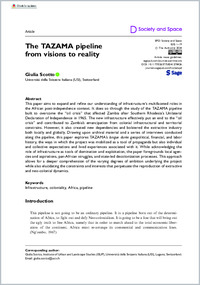The TAZAMA pipeline from visions to reality
- Scotto, Giulia ORCID Università della Svizzera italiana, Switzerland
- 2024
Published in:
- Environment and planning D : society and space. - 2024
English
This paper aims to expand and refine our understanding of infrastructure’s multifaceted roles in the African post-independence context. It does so through the study of the TAZAMA pipeline built to overcome the “oil crisis” that affected Zambia after Southern Rhodesia’s Unilateral Declaration of Independence in 1965. The new infrastructure effectively put an end to the “oil crisis” and contributed to Zambia’s emancipation from colonial infrastructural and territorial constrains. However, it also created new dependencies and bolstered the extractive industry both locally and globally. Drawing upon archival material and a series of interviews conducted along the pipeline, this paper explores TAZAMA’s longue durée geopolitical, financial, and labor history, the ways in which the project was mobilized as a tool of propaganda but also individual and collective expectations and lived experiences associated with it. While acknowledging the role of infrastructure as tools of domination and exploitation, the paper foregrounds local agencies and aspirations, pan-African struggles, and state-led decolonization processes. This approach allows for a deeper comprehension of the varying degrees of ambition underlying the project while also elucidating the constraints and interests that perpetuate the reproduction of extractive and neo-colonial dynamics.
- Collections
- Language
-
- English
- Classification
- Urbanism
- License
- Open access status
- hybrid
- Identifiers
-
- DOI 10.1177/02637758241278426
- ARK ark:/12658/srd1330481
- Persistent URL
- https://n2t.net/ark:/12658/srd1330481
Statistics
Document views: 58
File downloads:
- Scotto_2024_Sage_Env and planning_The Tazama pipeline: 39
